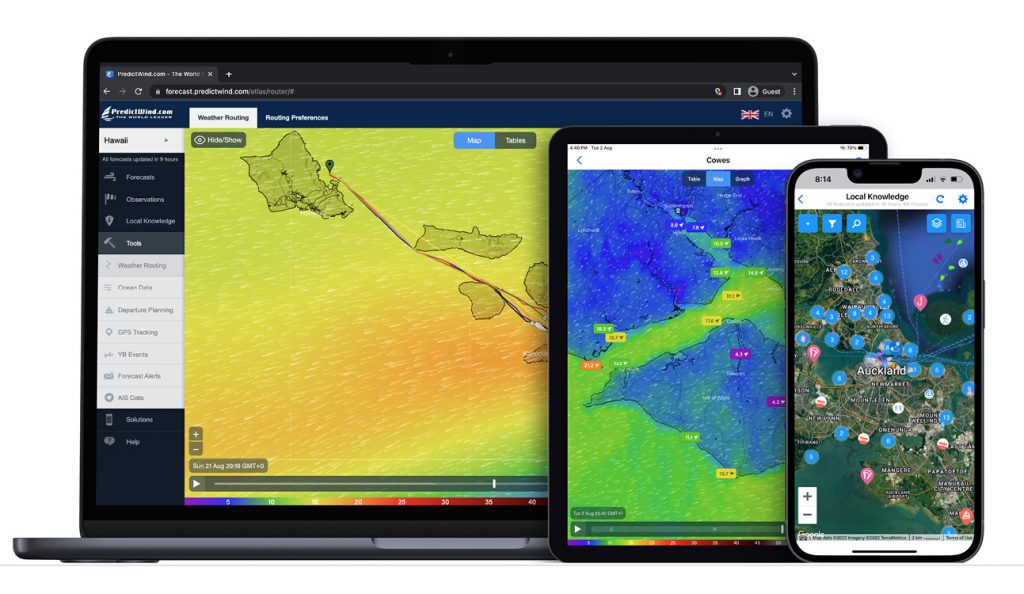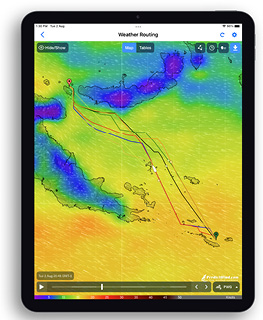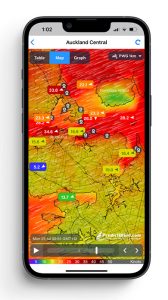By Jon Bilger
For people who love sailing, cruising, or any other water-based activity, understanding weather conditions can literally be a matter of life and death. In addition, being able to predict winds and other weather changes results in a more comfortable and often faster journey. The ocean is a terrific place to travel, but it can also be extremely dangerous for those who don’t take the proper precautions.
Planning the right weather window can save time, fuel, and most importantly, lives. In this article, we’re going to discuss the importance of understanding weather conditions when out on the water, with some tips that you should consider before any journey.

With a goal to deliver the most accurate forecast data available, PredictWind is available for a variety of devices.
The importance of boating weather safety for inexperienced or shorthanded crews
Like anything in life, experience is extremely valuable. Experienced sailors are often better equipped to deal with surprise weather conditions, although that doesn’t mean they ignore weather forecasts. In fact, people with experience on the water know exactly what to look for and harness technology such as PredictWind to plan their journeys more safely.
However, those with less experience, or even shorthanded crews such as cruising couples or families should be even more informed before embarking on a trip. With fewer hands on deck, everything becomes a little bit more difficult. So, coping with severe weather conditions is harder and inherently more dangerous. This is exactly why inexperienced or shorthanded crews need access to the best weather information available before planning any journey on the open seas.

PredictWind’s Wind Maps puts data on velocity, direction, shifts and more at your fingertips.
How does the weather impact the ocean?
Weather conditions are likely to affect most outdoor activities, but out on the water, the risks are even more prevalent. Even the largest vessels are at the mercy of the ocean, and that’s why planning is so important. When high winds are present on land, for example, you can seek shelter quickly. On the water, wind and other weather changes have a much greater impact. We won’t delve too deeply into the science, but here are some ways that the weather can affect your boating journey.
* Waves: Wind is the major factor in creating waves. Naturally, strong winds are likely to cause larger waves, while lesser winds result in a calmer ocean. Waves are obviously a hazard for boats if they are larger than your vessel is equipped to handle. While they can be dangerous, waves are at least visible to the naked eye, whereas other water conditions may not be.
* Currents: Currents in the ocean are caused by a variety of factors, including wind, changes in air pressure, temperature and storms just to name a few. While not necessarily a hazard for larger vessels, experienced sailors understand how to use currents to their advantage. At the very least, a strong current could take you off your intended course, which can be dangerous enough in itself.
* Tides: The gravitational forces from the moon and sun are the primary drivers for tidal movement. In effect, the tide is simply water levels rising and falling. It’s important to understand how tides might affect your journey.
While these are the major factors affecting the ocean, they certainly aren’t the only weather conditions that can affect ocean users. Wind, storms, rain and lightning are just a few weather events that can make sailing difficult, and they are all reasons that weather planning is essential.

Continuous monitoring of weather conditions helps ensure a safe passage.
Key weather safety tips
While these tips are targeted towards people sailing on the open seas, it’s important to remember that weather safety is crucial for all water vessel operators. From kayaking trips and casual days fishing with friends to transatlantic cruising, sudden weather changes can have disastrous consequences. Here are some key safety points to remember at all times.
Plan your route
Planning is everything when out on the water. Typically, you’ll know your starting point and destination, which thanks to the ultimate sailing companion, PredictWind, is all you need to plan a safe journey. Of course, you should always have an understanding of weather conditions and how they may affect your trip. But PredictWind’s weather routing feature makes planning a lot easier.
The system uses the best global and regional forecasting models to show you the safest, fastest and most comfortable route to your destination. Using complex algorithms that consider wind, waaves and all other weather conditions, PredictWind is your ultimate planning tool.
Choose your weather window
Whether you’re day sailing or embarking on a longer journey, timing is everything. For all coastal or offshore travel, choosing the right season, month, week, day and even hour to leave is often the best way to avoid severe weather conditions and make your journey a safe one. Once again, PredictWind gives sailors of all experience levels the information they need to properly choose their departure date, down to the hour!
PredictWind’s Departure Planning tool shows you the optimal day to depart, providing you with detailed weather information for the next 4 days. So, all you need to do is enter your start and end points, and the system shows you what conditions you’re likely to encounter, depending on the day you leave. Nobody likes to delay a trip, but safety always comes first, and PredictWind gives you the best chance of a successful and safe journey.
Monitor global weather patterns
Getting a global view of weather patterns is important for planning a safe trip. You can monitor these weather patterns over any length of time using a range of different sources, such as the GMDSS forecast which is written by a professional meteorologist. Local weather conditions are also important, which is why PredictWind’s app uses data from the most reliable sources on the planet.
High-resolution modeling and GRIB files are a big part of this, and although PredictWind does a lot of the work for you, it pays to really learn about weather conditions, forecasting and modeling to better understand the data you’re given. Forecasting is important for predicting extreme weather events, which is why tools like this really can be life-saving.
Notify others of your itinerary
Once you understand all of the weather conditions you may encounter on your journey, and you’ve chosen the optimal departure date, don’t forget to keep people informed. Your vessel should be equipped with all the safety devices you can imagine, from the basics like personal floatation devices (PFDs) and flares, you should also have GPS and EPIRB systems as well as communication devices such as satellite phones and VHF radios.
However, even with the most careful safety planning, there is still a safety risk when travelling on the open sea. As a backup for all of your safety precautions, always notify others of your itinerary. You can use apps to share your travel plans, post them on social media where they are easily accessible, or simply email your detailed plans to close friends or relatives. This ensures that if something does go wrong, authorities will have a better chance of tracking your travel route.
Have a plan B
We’ve already touched on the importance of planning, but the best plans always include a backup. You should always build contingencies into your travel plan to ensure you stay safe in the event of unexpected weather conditions. In addition to being well-equipped with safety gear, you should know where you can seek safety along the way.
Look for sheltered points where you can stop and anchor if required. Reaching a destination later than expected is far better than not reaching it at all, so if you need to veer a little off course to take a break or escape bad weather, you should do so. If you’re travelling long distances, you should also know which countries you might pass along the way, and understand their entry requirements.
Importantly, highlight every one of these potential stops in your travel itinerary that you share with friends.
Continue monitoring weather conditions along your journey
Finally, don’t disregard the importance of continuous weather monitoring. Using PredictWind’s superior weather routing and departure planning tools is just the first step in ensuring safe passage. You should continue using PredictWind’s features such as the Daily Briefing, Wind Maps, Forecast Tables and Graphs and a whole range of other maps and graphs for specific weather factors.
Careful monitoring of these tools ensures you’re alerted to any changes in weather patterns, and most importantly, any extreme weather events that may be predicted. Remember, even with the most careful planning, the weather and waves can change suddenly. Make sure you stay ahead of unfavorable conditions by using all of the data you can access.
To learn more about PredictWind, log onto PredictWind.com. ■
Olympian, two-time America’s Cup winner, and New Zealand National Champion in multiple classes, PredictWind Founding Director Jon Bilger spent years accessing the very best private wind and marine forecasting tools in the world. Jon founded PredictWind in 2010 to share this potentially life-saving technology with the public at large, and today PredictWind provides the world’s most accurate and reliable forecasting technology to more than a million users. A lifelong competitive yachtsman, Jon lives in Auckland with his wife and two daughters, who share his passion for the ocean and competitive sailing.
